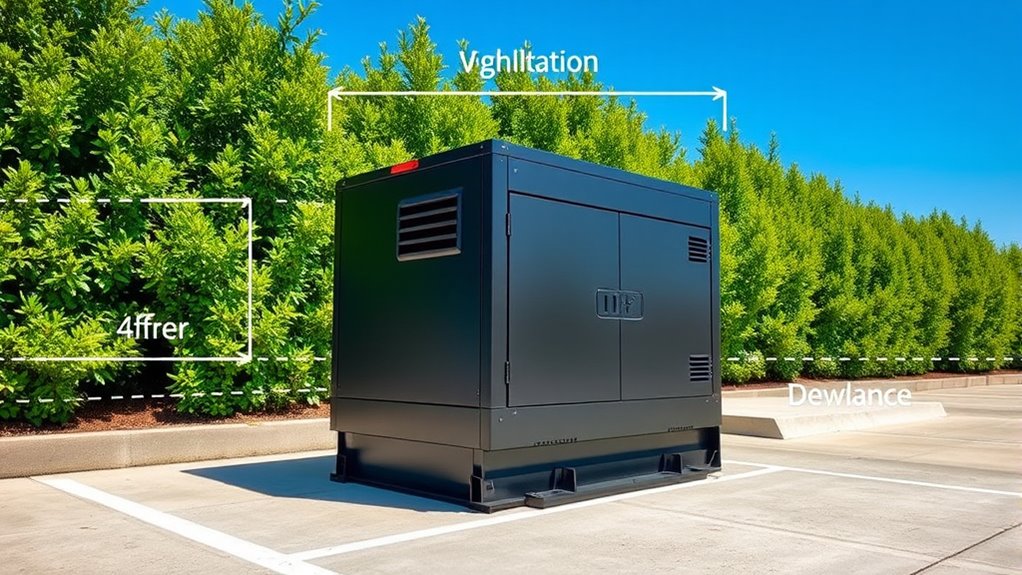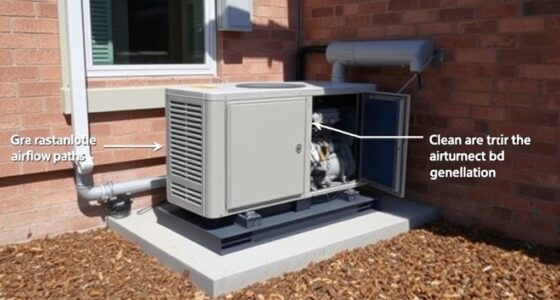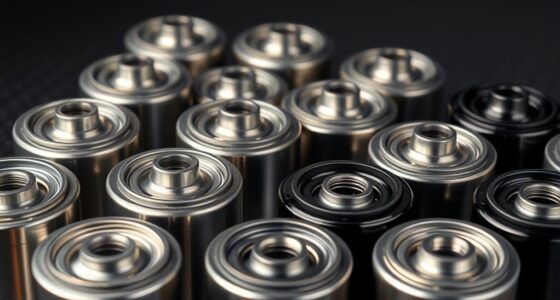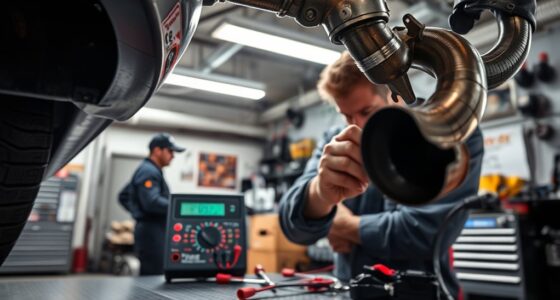To guarantee your generator runs safely and efficiently, place it outdoors on a flat surface, keeping at least 18 to 24 inches of clearance on all sides. Regularly remove debris and blockages, and use well-ventilated enclosures if needed. Proper spacing prevents overheating, reduces noise, and keeps exhaust gases safely dispersed. Following these basic guidelines helps extend your generator’s lifespan. Keep going to discover more essential tips for ideal ventilation and clearance practices.
Key Takeaways
- Place the generator outdoors on a flat, level surface, maintaining at least 18-24 inches of clearance on all sides.
- Keep the generator away from windows, vents, and openings to prevent exhaust fumes from entering enclosed spaces.
- Regularly inspect and clear debris, foliage, and objects around the generator to ensure unobstructed airflow.
- Use well-ventilated enclosures with vents or louvers that do not block airflow, balancing noise reduction with proper ventilation.
- Follow manufacturer guidelines for clearances and ventilation to prevent overheating, reduce noise, and extend engine lifespan.
Essential Ventilation and Clearance Tips

Proper ventilation and clearances are vital for the safe and efficient operation of your generator. When setting up your unit, paying attention to ventilation isn’t just about safety—it also impacts fuel efficiency and noise reduction. Adequate airflow ensures the engine runs smoothly, preventing overheating that can decrease fuel economy and cause unnecessary wear. If your generator doesn’t have proper ventilation, it may consume more fuel than necessary, as the engine struggles to cool itself efficiently. Additionally, poor ventilation can lead to increased noise levels, making your generator more disruptive and potentially violating local noise ordinances. Making sure you maintain proper clearances around your generator not only helps it operate more quietly but also improves overall performance.
When choosing a location, think about the generator’s airflow needs. Keep it outdoors, ideally on a flat, level surface, and position it away from windows, vents, or any openings that could allow exhaust fumes to enter your home. Proper clearances mean leaving enough space on all sides—generally at least 18 to 24 inches—to promote good air circulation. This spacing helps exhaust gases disperse safely and prevents fumes from accumulating, which is essential for your safety and the environment. It also allows fresh air to flow in, aiding combustion efficiency and helping the engine run more economically, thereby conserving fuel.
Another key aspect is making sure the ventilation area isn’t obstructed by debris, foliage, or objects that could block airflow. Regularly inspect the area around your generator and clear any obstructions. This proactive approach maintains ideal airflow, reducing the risk of overheating and lowering noise levels by preventing the engine from working harder than necessary. Proper clearances also minimize the buildup of heat beneath or around the generator, which can otherwise lead to increased fuel consumption and louder operation due to overheating components. Furthermore, understanding generator design can help you select the best setup for optimal airflow and safety.
Finally, consider the type of enclosure or housing you use. While some generators are designed for outdoor use without additional barriers, if you opt for a sound-dampening enclosure, make sure it’s well-ventilated. Incorporate vents or louvers that allow air to flow freely while containing noise. This setup not only improves noise reduction but also maintains the necessary airflow for fuel efficiency and safe operation. Following these guidelines ensures your generator runs quietly, efficiently, and safely, providing reliable power when you need it most.
Frequently Asked Questions
How Often Should Generator Ventilation Systems Be Inspected?
You should inspect your generator ventilation systems at least once every three to six months. Regular checks help guarantee good air quality and prevent overheating, which could increase noise levels and compromise safety. During inspections, look for blockages, leaks, or debris that could obstruct airflow. Maintaining proper ventilation keeps your generator running efficiently, reduces noise, and safeguards both your equipment and environment.
Can Ventilation Requirements Vary by Generator Size or Type?
Yes, ventilation requirements can vary by generator size or type due to ventilation variability and generator specifications. Larger or more powerful generators often need more extensive ventilation to prevent overheating and ensure safe operation. Different generator models or fuel types may have specific clearance and airflow needs, so always consult the manufacturer’s guidelines. Adjusting ventilation based on these factors helps maintain efficiency, safety, and compliance with local codes.
Are There Specific Outdoor Conditions That Affect Clearance Needs?
Yes, outdoor conditions like weather considerations can impact clearance needs. Strong winds or heavy rain may affect airflow patterns around your generator, requiring extra space for proper ventilation and safety. Cold temperatures could also influence clearance requirements to prevent moisture buildup or ice formation. Always evaluate local weather patterns and guarantee sufficient clearance to maintain ideal airflow, protect your generator, and prevent safety hazards during extreme conditions.
What Are the Consequences of Inadequate Generator Ventilation?
Inadequate generator ventilation can lead to serious fire hazards and increased carbon monoxide risks. Without proper airflow, your generator might overheat, causing fires or damage. Carbon monoxide, a deadly gas, can accumulate if ventilation is deficient, risking poisoning for anyone nearby. Always guarantee your generator is well-ventilated and clear of obstructions to prevent these dangers and keep everyone safe.
How Do Local Building Codes Influence Clearance and Ventilation Standards?
You should pay close attention to local building codes because they set the gold standard for clearance and ventilation, and ignoring them could land you in hot water. Zoning restrictions and environmental hazards are key factors influencing these standards, ensuring your generator operates safely without risking fire or pollution. Follow these rules carefully—think of them as your safety net—to avoid fines and protect your property and community.
Conclusion
By following these ventilation and clearance tips, you’ll guarantee your generator operates safely and efficiently. Some might think it’s just extra hassle, but proper ventilation prevents dangerous fumes and prevents damage. Taking a few extra minutes now saves you from costly repairs or safety hazards later. Remember, a well-ventilated generator isn’t just about compliance—it’s about protecting yourself and your loved ones. Stay proactive, stay safe, and keep your generator running smoothly all year round.









